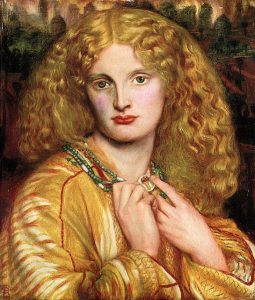
“Helen of Troy,” oil-on-canvas, 1863 Photo Credit: Dante Gabriel Rossetti
In September 2020, the first-ever assignment in my Lit Hum section was to develop an intralingual translation of the first seven lines of the Iliad. We had the standard version of the Iliad prescribed by the Core Office—Richmond Lattimore’s 1951 translation—and from the very beginning of the course our instructor made it clear that our access to this text, or to any of the other texts in Fall Lit Hum, would be mediated by a translator; that the translator was hardly transparent; that to engage in a close-reading of any of these works in translation, we had to understand the literary and historical context not only of the original text, but also, crucially, of the translator(s). I still recall rich seminar discussions in which we compared Lattimore’s translation of sections of the Iliad to those of other translators, with an eye towards issues of gender—for instance, interrogating the derogatory language Lattimore’s Helen used in reference to herself to describe her abandonment of her husband, Menelaus. What did this reveal about notions of gender in Ancient Greece—and in 1950s America? For our purposes, whatever Helen thought of her actions in Homer’s text was mediated by Lattimore.
In its most literal sense, the intralingual translation was an assignment to render Lattimore’s lines in our own register. More broadly, it was our instructor’s means of opening up the world of language and translation to us, a world that has often been marked by exclusion, inaccessibility, and high entrance barriers, but is enthralling in its possibilities and potential.
Later that summer, I started a research project through the Laidlaw Scholars Program on the Indian feminist poet, educator, and activist Mahadevi Varma, known as Mahadevi (1907-87). Early in this process, I encountered linguistic roadblocks—Mahadevi wrote almost exclusively in Hindi and was inspired by the Sanskrit literary tradition, but I had no background in Sanskrit and had not engaged with Hindi academically since shifting school systems in 2014. Mahadevi’s work, moreover, addressed the politics of writing in Hindi and studying Sanskrit as a young woman in 1930s British India. Her rejection of the English language was intentional, I learnt, borne out of her rejection of the colonial education system and her desire to establish Hindi as a literary language, and her interest in Sanskrit stemmed from an interest in developing resistant, novel readings of Hindu doctrine that could be emancipatory for Indian women. How was one to critically engage with her work—in its original form or translation—with an attentiveness to the politics of language and translation?
The experience of working with Mahadevi’s writings in Hindi and in translation that summer, and my Laidlaw research mentor’s advice and encouragement, ignited my interest in the wealth of language and translation coursework available at Columbia. While I had frequently heard of the language offerings in reference to the Core language requirement, as a double-major scrambling to balance out the various prerequisites and requirements, I had not thought to engage in myself. I took a summer course in Hindi at the American Institute of Indian Studies, which offers language courses in a variety of South Asian languages and means to apply for funding to subsidize program fees, later enrolled in Sanskrit and French, and am now looking forward to studying Urdu. These language courses, which I had begun out of a desire to finish out the Core language requirement and extend my summer research project on Mahadevi, ended up introducing me to new linguistic and historical worlds. They introduced not only unfamiliar grammatical structures, vocabularies, and pronunciations, but also new forms of literary imagination, internal logics, structures of argumentation, self-expression, and historical thinking. I came to appreciate the process of translation as well as the impossibility of a perfectly transparent translator, studying works of translation theory, comparing different translations of the same work, and learning to develop my own renderings of a text.
As a history student, I found that each of these languages opened up new windows into some moment in the past—sparking interests in twentieth-century Indian feminist writings and political activism around religious reform, conceptions of linguistic and political nationalism in the Bangladesh Liberation War of 1971, nineteenth-century Orientalist scholarship on Sanskrit literary works such as the Abhijñānaśākuntalam, or eighteenth-century French Jesuit missionaries in colonial Pondichéry writing about Hinduism. I continued to encounter figures who, for a range of different reasons, have not been considered important enough to translate into English by the Western academy, or whose works have been subject to appropriation and mistranslation under colonial rule, making it essential to engage with the original source-text. Through the process, I have realized that language and translation is perhaps one of the most important—if underrated—elements of the Core, whether through the possibility of studying a new language or developing one’s knowledge of a familiar one through the language requirement, or the myriad works-in-translation that populate the Lit Hum and CC syllabi, starting with that first intralingual translation assignment in Fall 2020.
